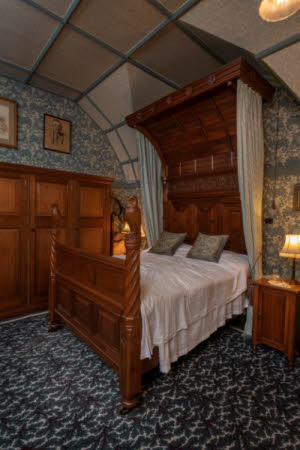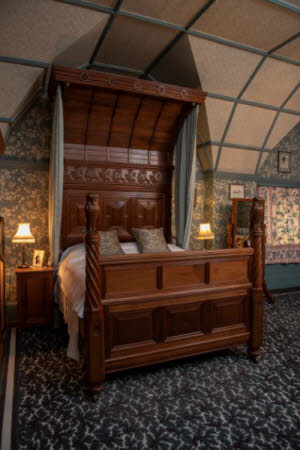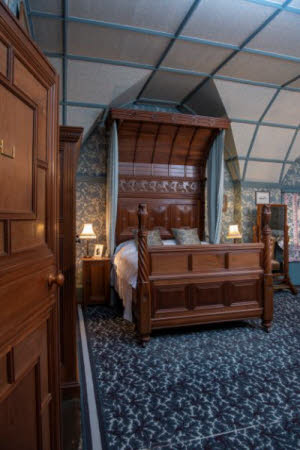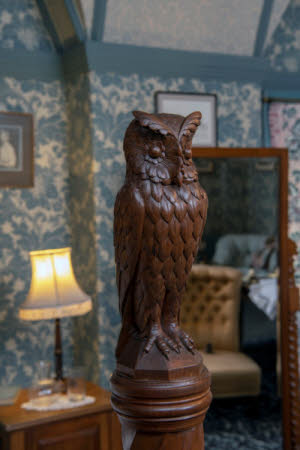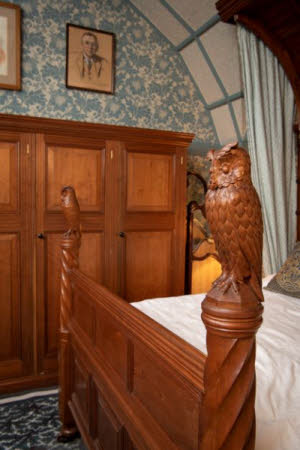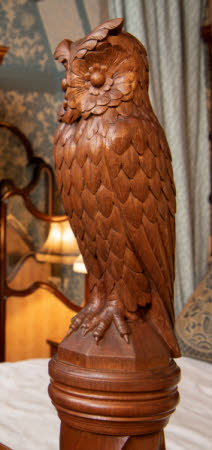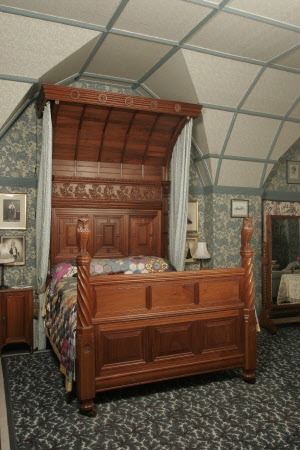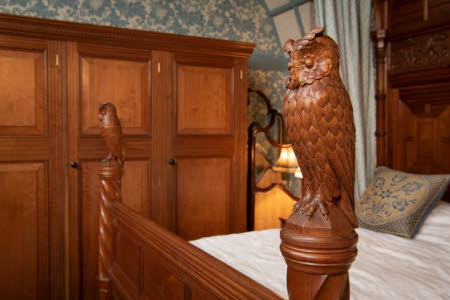Half-tester bed
Richard Norman Shaw (Edinburgh 1831 - London 1912)
Category
Furniture
Date
circa 1875
Materials
Walnut, oak, textile, hair, feather
Measurements
300 cm (H); 166 cm (W); 209 cm (L)
Order this imageCollection
Cragside, Northumberland
NT 1227312.1.1
Summary
A walnut and oak half-tester bed, English, circa 1875, designed by Richard Norman Shaw RA (1831-1912), and probably executed by W. H. Lascelles (1832-1885), part of the so called Owl Suite, also comprising NT 1227312.2, a double bed and NT 1227312.3, a single bed. The headboard of three rectangular panels each centred by a fielded panel in a surround with a moulding at each cardinal point, framed by further moulded rails. Beneath a frieze delicately carved with nine poppy plants between dentil edge mouldings and an arched half-tester canopy formed from slats with applied dividing mouldings. The canopy topped by a cornice of complex mouldings carved to its frieze with rosettes. The headboard flanked to either side by an engaged hexagonal column with moulded knops and moulded capitals. The footboard formed from three fielded panels beneath three plain panels, in moulded and reeded surrounds, all between a pair of posts topped by perching owls on spiral-fluted and stop-chamfered posts. On bun feet with castors.
Full description
This bed, and its two companions, were made around 1875 and installed in the suite of three rooms used by the Prince and Princess of Wales – the future Edward VII and Queen Alexandra - on a visit to Cragside in August 1884. The entertainments laid on for their visit were lavish – 10,000 lamps illuminated it and fireworks were launched from six balloons – and the amenities provided in their rooms were modern and up-to-date: hot and cold running water, a sunken bath, electric light, central heating and these Arts & Crafts beds. (1) This, the largest bed in the largest of the three rooms, was probably used by the Prince of Wales. The second bed (NT 1227312.2), made for the suite’s middle room, was discovered in a Leicestershire barn around 2006 and returned to Cragside in March 2007, where it was found to bear a plaque reading ‘Princess Alexandra occupied this bed when visiting Cragside’. The third bed (NT 1227312.3) occupied the smallest room and was probably used by a lady or gentleman-in-waiting. The beds are thought to have been designed by Richard Norman Shaw (1831-1912), the Scottish-born architect who rebuilt Cragside, the home of William Armstrong, 1st Baron Armstrong (1810-1900), in several phases between 1869 and 1885. Shaw’s furniture tended to fall into two groups – light and delicate – or, like these beds, masculine and sturdy. (2) The poppies and owls which decorate this bed both represent, or are intended as attributes of ,‘Sleep’ (owls are nocturnal creatures and poppies induce sleep) and were used by other designers for bedroom furniture and decoration. See, for instance, a design by John Dando Sedding for the decoration of a bedroom fireplace, which included owls, poppies, woody nightingale, moths and stag beetle, all symbolic of Night and Sleep. (3) The design may be related to a similar bed, designed in 1877 by George Faulkner Armitage (1849-1937), traditionally thought to have been made for Queen Victoria’s cancelled visit to open Manchester Town Hall, whose posts were also carved with owls. (4) Shaw and Lascelles displayed another bed with owl finials in 1877 in an annexe to the 1862 Exhibition Building run jointly with the Royal School of Art Needlework. (5) Some of the pieces were highly praised as pioneering in both the Building News and the Furniture Gazette. (2) William Henry Lascelles (1832-85) was a builder and pioneer in the use of concrete. He also designed and made furniture: in 1870, he registered his first patent, ‘an improved construction of Office Table’ where articles stored within the frame could be brought to hand without disturbing the writer. R. Norman Shaw used him to build Hopedene in Surrey (1873-5) and many other London houses. (6) (1) Cragside: Nothumberland (National Trust, 1982 (2) Andrew Saint, Richard Norman Shaw (Yale University Press, New Haven and London: Revised Edition, 2010), 191-5, Fig. 169 (3) Margaret Richardson, Architects of the Arts & Crafts Movement (Trefoil Books, London: 1983), p. 38, Plate VI (4) Rosamond Allwood, ‘George Faulkner Armitage 1849-1937’ in Furniture History XXIII (1987), 67-87, p. 74, fn. 4. (5) 'Royal School of Needlework', in Survey of London: Volume 38, South Kensington Museums Area, ed. F H W Sheppard (London, 1975), pp. 231-232. British History Onlinehttp://www.british-history.ac.uk/survey-london/vol38/pp231-232 [accessed 15 June 2022]. quoting Building News 23 March 1877, pp. 285-6 (6) ‘Lascelles, William Henry’ in Dictionary of business biography: a biographical dictionary of business leaders active in Britain in the period 1860-1980 (1984), pp. 655 – 658
Provenance
Armstrong collection. Transferred by the Treasury to The National Trust in 1977 via the National Land Fund, aided by 3rd Baron Armstrong of Bamburgh and Cragside (1919 - 1987).
Makers and roles
Richard Norman Shaw (Edinburgh 1831 - London 1912), designer probably William Henry Lascelles (1832 - 1885), maker
